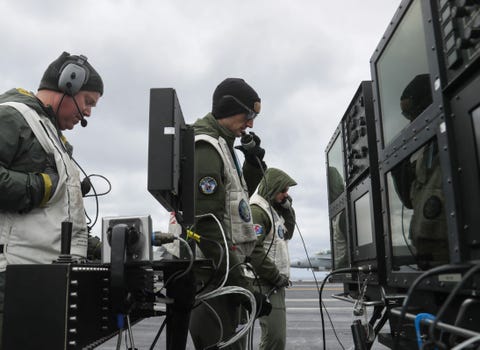U.S. Navy Lands Fighter Jet on Aircraft Carrier Via Remote Control
The joystick-based landing system is called ATARI. Because of course it is.
By Kyle Mizokami
U.S. NAVY PHOTO BY CHIEF MASS COMMUNICATION SPECIALIST MARK LOGICO
The US Navy recently landed a strike fighter on the deck of an aircraft carrier without the pilot inside actually doing anything. Instead, an officer aboard the carrier guided the aircraft down by remote control. The system, known as ATARI, is meant to solve the problem of landing unmanned aircraft during emergencies.
The test landings took place in late March aboard the aircraft carrier USS Abraham Lincoln. The system is called aircraft terminal approach remote inceptor, or ATARI for short, and consists of an F/A-18 Hornet strike fighter outfitted for remote operation.
ATARI gives the landing signal operator—a carrier pilot trained to guide other pilots to a safe landing—the ability to land an aircraft. The officer is situated at the edge of the carrier flight deck and equipped with instruments that show an incoming airplane’s glidescope and lineup errors, providing him or her with the ideal vantage point and data for remotely landing a plane.

Landing signal officers work with the aircraft terminal approach remote inceptor in preparation for incoming aircraft to land on the flight deck of the Nimitz-class aircraft carrier USS Abraham Lincoln.
U.S. NAVY PHOTO BY MASS COMMUNICATION SPECIALIST 1ST CLASS JOSUE ESCOBOSA
According to the U.S. Navy, the ATARI system’s first successful carrier landing involved a manned F/A-18 Hornet strike fighter from the “Salty Dogs,” a Navy flight test squadron. The Hornet performed three near-landings, known as waveoffs, as last-minute tests of the system before bringing the Hornet in for an actual landing. A previous version of ATARI was tested on land using a modified Learjet.
Ultimately, ATARI is meant for unmanned airplanes landing on carrier decks. The Navy conducted its first unmanned takeoffs and landings in 2013 with the experimental X-47B drone. Although the service doesn’t have any unmanned carrier aircraft yet, the MQ-25 Stingray unmanned tanker will enter service in the mid-2020s. The MQ-25 will likely have its own takeoff and landing system, but ATARI technology will be available in case of emergencies. The system, or something like it, also could land a manned aircraft in the event the pilot is incapacitated, provided the ATARI system is not too expensive or gets in the way of the pilot in the cockpit.
If the U.S. Navy can successfully control Hornet fighters through the toughest part of flight operations—landing on on aircraft carrier—it seems likely aircraft like the Hornet could be remotely operated for the rest of the flight as well. This opens up the possibility the service’s successor to the F/A-18 Super Hornet, Next Generation Air Dominance, could be optionally manned.
No comments:
Post a Comment